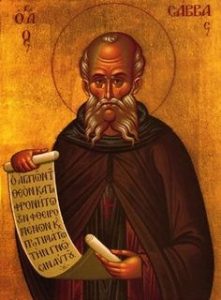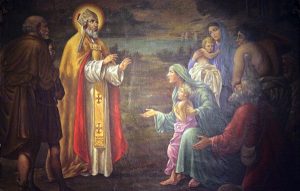 Saint Sabas
Saint Sabas
Patriarchal Abbot in Palestine (439-531)
Feast – December 5
Saint Sabas, one of the most renowned patriarchs of the monks of Palestine; founder of several convents, most notably the one known as Mar Saba; and considered one of the founders of Eastern monasticism. The saint’s name is derived from Aramaic: סַבָּא Sabbāʾ meaning “old man.” Son of John, a military commander, and Sophia, born at Mutalaska near Caesarea of Cappadocia in the year 439. The name of the village has no known meaning in Greek, but the Aramaic “Mata la zkha” translates as “Village of Victory”.
Journeying to Alexandria on military matters, his parents left their five-year-old son in the care of an uncle. Mistreated by his uncle’s wife, St. Sabas ran away to another uncle. When the two uncles became involved in a lawsuit over his estate, he again ran away, this time to the nearby monastery of Bishop Flavian of Antioch. The gifted child quickly learned to read and became an expert on the Holy Scriptures. By the time the uncles were reconciled, the young boy felt drawn to monastic life. He resisted his parents’ pressure to return to the world and get married, he stated: “Do you want me to be a deserter, leaving God after placing myself in His service? If those who abandon the militia of earthly kings are severely punished, what chastisement would I not deserve if I abandoned that of the King of heaven?” He remained in the monastery.
Although the youngest monk in the house, he excelled in virtue. In 456, he went to Jerusalem seeking to learn more about living in solitude. Soon he asked to be accepted as a disciple of a well-known local solitary, though he was regarded as too young to live completely as a hermit he entered a monastery under St. Theoctistus. St. Sabas lived in a monastery, where he worked during the day and spent much of the night in prayer. When he was thirty years old, desiring greater solitude under the guidance of St. Euthymius, Abbot of a nearby monastery. He began to live an angelic life so far above nature that he seemed no longer to have a body. The young sage, as he was called by St. Euthymius, dwelt in a cavern on a mountain near Jerusalem, where he prayed, sang Psalms and wove baskets of palm branches. St. Euthymius attentively directed the life of the young monk, and seeing his spiritual maturity, he began to take him to the wilderness with him. They set out each January 14 and remained there until Palm Sunday. St. Euthymius called St. Sabas a child-elder and encouraged him to grow in the monastic virtues. When Euthymius died (c. 473), St. Sabas withdrew from the Lavra (a cluster of cells or caves for hermits, with a church and sometimes a refectory at the center) and moved to a cave near the monastery of St Gerasimus of Jordan. After the death of the Elder Theoctistus, his successor blessed Sabas to seclude himself in a cave near the brook Cedron. On Saturdays, however, he left his hermitage and came to the monastery, where he participated in divine services and ate with the brethren. After a certain time Sabas received permission not to leave his hermitage at all, and he lived in isolation in the cave for five years. A rope was his means of access. Wild herbs among the rocks were his food. Occasionally men brought him other food and items, while he had to go a distance for his water. Despite his desire for solitude, he attracted disciples. He was forty-five years old when he began to direct those who came to live as hermits, as he did, and he gave each of them a place to build a cell, living in individual huts. The traditional dating of the founding of this Lavra in the Kidron Valley, south of Jerusalem, is 484. Soon this was the largest monastery of Palestine. When his one hundred fifty monks asked for a priest and despite his opposition to monks being ordained, he was obliged to accept ordination by Patriarch Sallust of Jerusalem in 491, so that he could better serve his monastic community in leadership. He built several hospitals and another monastery near Jericho and was appointed archimandrite of all hermits in Palestine. While functioning as abbot among a large community of monks, he felt ever called to live the life of a hermit. Throughout each year—consistently in Lent—he left his monks for long periods of time, often to their distress. A group of 60 men left, settling at Thecuna, a nearby ruined monastery. When St. Sabas learned of the difficulties they were facing, he generously gave them supplies and assisted in the repair of their church.
As the years passed, he was in charge of seven monasteries; but his influence was not limited to Palestine. The heresies afflicting religion were being sustained by the emperor of Constantinople, Anastasios I who had exiled the Catholic Patriarch of Jerusalem Elias.
St. Sabas a strenuous opponent of the Monophysites and the Origenists, tried to influence the emperors against them by calling personally on Emperor. He converted the one who had replaced Elias and wrote to the emperor that he should cease to persecute the Church of Jerusalem, and to impose taxes on the cities of Palestine which they were unable to pay. The emperor died soon afterwards, and the pious Justin replaced him. Justin restored the true faith by an edict and recalled the exiles, re-establishing the exiled prelates in their sees.
Over the years St. Sabas founded several more monasteries. Strong supporter of theological orthodoxy and a vigorous opponent of Origenism and monophysitism, traveled throughout Palestine, preaching the true faith and successfully bringing back many to the Church.
It is claimed that many miracles took place through the prayers of St. Sabas: at a Lavra a spring of water welled up, during a time of drought they received abundant rain, and there were also healings of the sick and the possessed. He composed the first monastic rule of church services, the so-called Jerusalem Typikon, for guidance of all the Byzantine monasteries.
At the age of 91, in response to a plea from the Patriarch of Jerusalem, Sabas undertook a long journey to Constantinople to ask Justinian (successor to Justin), not to act with severity against the province of Palestine, where a revolt had occurred by the non-submission of a group of Samaritans. The emperor honored him highly and wished to endow his monasteries with wealth, but the holy Patriarch asked him to use the riches he was offering to build a hospice for pilgrims in Jerusalem, to decorate the unfinished Church of the Blessed Virgin, to build a fortress where the monks could take refuge when barbarians invaded the land, and finally, to re-establish preaching of the true Faith, by edicts proscribing the various errors being propagated.
He fell ill soon after his return to his Lavra from this trip and died on December 5th, 531 after naming his successor.
The Lavra he founded in the desolate, wild country between Jerusalem and the Dead Sea, named Mar Saba after him, often called the Great Laura for its preeminence produced many great saints, among them St John of Damascus. It is still inhabited by monks of the Eastern Orthodox Church and is one of the three or four oldest monasteries in the world.
St. Sabas’s relics were taken by Crusaders in the 12th century and remained in Italy in The Church of Saint Anthony in Venice, until Pope Paul VI returned them to the monastery in 1965 as a gesture of good will towards the Orthodox.
References and Excerpts
[1] F. Media, “Saint Sabas,” Franciscan Media, 05-Dec-2015. .
[2] C. Online, “St. Sabas – Saints & Angels,” Catholic Online. [Online]. Available: https://www.catholic.org/saints/saint.php?saint_id=758. [Accessed: 29-Nov-2018].
[3] “Saint Sabas, Patriarchal Abbot in Palestine.” [Online]. Available: http://sanctoral.com/en/saints/saint_sabas.html. [Accessed: 29-Nov-2018].
[4] “Sabbas the Sanctified,” Wikipedia. 09-Nov-2018.
 Saint Malachy d’Armagh
Saint Malachy d’Armagh